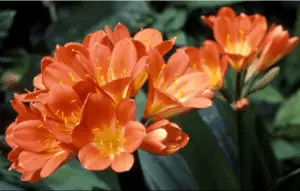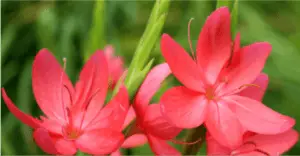What is Kaffir Lily?
Kaffir Lily (Clivia Miniata) is a species of flowering plants in the genus Clivia of the family Amaryllidaceous. It best suits for an indoor garden as it mostly prefers cold temperature and grows well in shady areas. Kaffir Lily is originally from South Africa, but today it is popular in New Zealand, Japan, China, Swaziland, and the USA. It is also renowned as Natal lily, Clivia Kaffir lily, fire lily, and bush lily though it is not a part of the lily family.
Kaffir lily grows into a large and clumsy plant with a height of about 45 cm (18 inches). The flower sometimes has a faint, but lovely smell and also consists small amount of lycorine (toxic crystalline alkaloid) that makes it poisonous.
It has wide and arching dark green leaves which is about 2 inches (5 cm) wide that might reach the length up to 18 inches (45 cm).
It is grown outdoors in warmer sites, and most people prefer to grow in landscapes for its attractive evergreen foliage and showy flowers.
Background of the Kaffir Lily Plant
Most people refer to the Kaffir Lily plant as “African Sensation.” The plant was first discovered in South Africa, which is where it gets its name from.
Since then, the plant has been grown in many different climates and cultures. It’s found in gardens all over the world. In fact, it’s one of the most popular perennials available. Image at top: a white kaffir lily flower The Kaffir Lily Plant is a perennial bulb that produces small scarlet flowers.
What are the available colors of Kaffir Lily?
Kaffir Lilies bloom in different colors like red, white, orange, peach, or yellow.
How To Grow Kaffir Lilies?
Kaffir lilies are slow-growing plants, which typically takes 2 or 3 years to produce flowers and becomes fully mature within five years. You can grow kaffir lilies through root splitting or seeds.
Growing through root splitting
- Use a knife and cut off the side shoots (about 20 cm long) of the plant from the root ball.
- Prepare a mixture of sand and turf in a flower pot and put the stalk on it.
- Pour moderate water into the flower pot.
- Please place the plant in a light place but avoid direct sunlight.
- You can slowly see roots emerging from the substrate. You can re-pot it using ordinary potting soil.
Growing Kaffir Lilies from seeds
You can extract seeds from the ripe berries of the plant.
- Fill a tub with the germinating seeds of lilies.
- Place the germinating seed on the top and press them very carefully.
- Use moderate water. You need good organic soil that drains well, and change the pot when necessary (after it has flowered) otherwise, do not disturb the plant.
How to care Kaffir Lilies?
You need to consider the following factors to grow and take care of the plant:
- Temperature: Kaffir Lily can adjust the temperature from cold to average 60 degrees Fahrenheit (15.5 C) to 75 degrees F (23.8 C).
- Light: It grows well in the shade but needs light too. Grow it outdoors but avoid direct sunlight.
- Water: Water the plants enough to keep the soil moist within summer, while in winter, water sparingly and allow the soil to become quite dry to get better results.
- Soil: Use good organic soil that drains well. You can use peat moss soil, which is better for your plant.
- Fertilizer: It requires diluted fertilizer once every two weeks.
- Feed the plant monthly with an average household humidity and balanced indoor plant food (high potassium foods).
- Insects would rarely bother the plant but if it happens, use pesticides.
- Please cut off dying flowers at the base of their stalk if any.
- Kaffir lilies is a bulb plant that needs rest for several months during the winter. To save your plant from dying, move your plant to a cool, dark spot during November.
The plant should be placed in an area that receives medium to high sunlight. They like well-drained soil and will not thrive in wet conditions.
However, they do need water periodically but are somewhat drought tolerant if you don’t over-water them. The best time to plant a clivia is during the spring months when it starts to warm up (in other words, after winter).
A clivia plant grows best in tropical conditions, with bright, warm sunlight. After it starts to grow it will grow very slowly.
This is the time when fertilizer should be applied to encourage further development of the plant’s roots and flowers. Eventually, once it has reached maturity (usually 8-10 years), it will die back to a single stem and produce flowers that are white and purple in color.
This stage of growth is when you will want to trim the clivia as needed because they will eventually start to wilt under the heat of summer days. The stems often turn brown at this point from the sun’s exposure, but can still be trimmed back as needed without killing the plant.
Can Kaffir Lily live outside?
Yes, but they are tropical plants and will die from lack of humidity in a cold environment. You can also keep it inside your house by placing it in a room that has bright light and high humidity. They can also be kept outdoors at night without any problems.
Where do you place the Kaffir Lily?
The plant likes a little bit of shade, especially during the hottest hours of the day in summer when the sun is at its highest. It should be placed where it can get some protection from intense light or heat sources. It also likes humidity; however, this will mean keeping it indoors during the winter months.
Do Kaffir lilies like lots of water?
Clivias like to be watered regularly, but they don’t require as much water as a lot of other flowering plants. They’re drought-tolerant and can survive in dry conditions for long periods of time.
How do I get my Kaffir Lily to bloom?
Clivias need exposure to the sun in order to bloom. If you live in a colder climate, your clivias may not bloom every year. Clivias are tropical plants that need warmer weather and lots of sunlight to flower, but they don’t require much water or fertilizer.
When do Clivias (Kaffir Lily) bloom?
They usually flower in summer and fall, but this can vary between varieties. Some varieties don’t produce flowers very often.
Also, clivias don’t always flower every year and it’s normal for them not to bloom for longer periods of time. How do I get my clivia’s leaves to grow wide?
The wider the leaves get the better a light source is needed. To keep the leaves from getting scorched by strong sunlight you can put some shade cloth (like a garden tarp or sheet) between the clivias and the sun.
What to do with clivia after flowering?
After the flowers have faded away look for the seed pods. The seed pods need to be allowed to dry completely before being collected. When the seed pods are completely dry they will start to shrivel up and then fall off.
Uses of Kaffir Lily
- Kaffir lily is a beautiful large plant that you can cultivate as an ornamental plant for its flowers.
- It helps to add attraction to your house, office, or garden.
- A beautiful flower always refreshes you.
Where can I buy Kaffir Lily seed and live plant?
You can find Kaffir lily plant for sale in Amazon. You can also find seeds that you can grow yourself in the store.
Sources:
https://en.wikipedia.org/wiki/Clivia_miniata
https://www.uaex.uada.edu/yard-garden/resource-library/plant-week/lily-kaffir-4-27-07.aspx

Amelia is a plant and nature lover! Ever since she was little, she loved spending time in her family’s garden and learning about how to care for each plant individually. As an adult, she has dedicated herself to sharing what she has learned and continuing to expand her knowledge on the plant kingdom.


